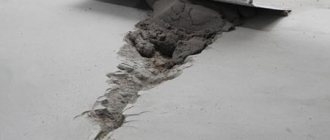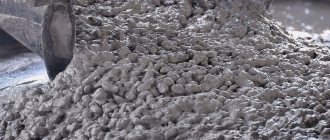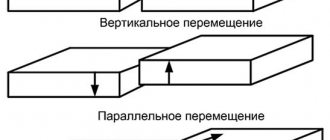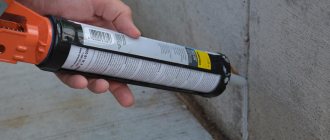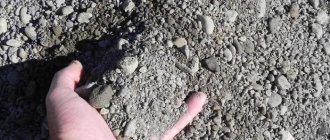Asphalt is considered a reliable and durable material, which is taken for a long service life. But this characteristic is valid for a properly laid coating without damage.
The presence of holes, cracks, breaks and other defects makes the material vulnerable to water, ice and other environmental factors. It loses its strength, breaks down and wears out faster.
In order for the covering of an asphalt path or site to serve for many years, cracks in it must be promptly patched.
In this article we will consider the following questions:
- How cracks accelerate the destruction of asphalt
- How to fill cracks in asphalt
- How to repair a crack in asphalt with your own hands
- What equipment is used for large-scale crack repair?
The first part of the article is intended for people who are still new to the features of the material. If you are already aware of such subtleties, then you can immediately move on to the blocks with practical information.
The final section will be useful for those for whom manual filling of cracks is not suitable - for example, if you need to repair a large asphalt area (yard of an apartment building, parking lot, road, etc.).
Why do you need to repair cracks in asphalt?
This article will discuss one of the most common asphalt defects. Sooner or later, both the top layer of a busy highway and the covering of a private yard will crack. This happens for various reasons: due to high loads, temperature changes or aging of the binder bitumen.
Few people realize that cracks not only spoil the appearance of asphalt, but also affect its durability. The fact is that the damaged coating loses its integrity and waterproofness. Foreign matter begins to accumulate in damaged areas.
These include:
- Water Water molecules penetrate under the bitumen films on the surface of filler grains (crushed stone and sand) and cause them to peel off. And when it gets colder, the moisture freezes and expands, pushing the asphalt from the inside like a wedge.
- Chemical reagents Salts and saline solutions, which are used to combat ice, accelerate the aging of bitumen. Because of this, asphalt quickly loses its quality and begins to crumble.
- Solvent substances These include gasoline, kerosene, motor oils and other technical fluids that motorists often have on their households. Flowing into cracks in the asphalt, they begin to corrode the bitumen.
- Plant seeds Earth accumulates in cracks, which is saturated with moisture and provides the seeds with conditions for germination. Young sprouts are rapidly destroying the asphalt around them in the struggle for life and a place in the sun.
If you give up on small asphalt defects and let things take their course, large holes and potholes may appear in place of the cracks within a season. And vice versa, if you eliminate them in their infancy, then the service life of the coating can be extended by 3-4 years, or even more.
We will talk about how such repairs are carried out and what materials are used for them in the continuation of the article.
The problem of repairing potholes on the roads
For almost the entire population of Russia, potholes on the roads are a real disaster. It occurs everywhere: on the way to work, on the way to the store. Constant stumbling causes only one desire: to quickly fill the hole in the asphalt or fill it with something. From a human point of view, the most economical method is to fill the hole with a beetle or a solution of sand and cement. This method of solving the problem is short-term, since in the future, the compacted solution is quickly broken by cars constantly passing over it. The problem can be solved without the use of professional labor by using an innovative material - liquid asphalt.
The reasons why you should give preference to liquid asphalt are:
- Easy to install material.
- Possibility of instant use of the finished consistency.
- Save money on renting expensive equipment and purchasing styling tools.
- Possibility of laying asphalt pavement and filling holes under temperature changes and different humidity levels.
- Providing a manufacturer's warranty.
- Long shelf life of the material.
Despite the fact that the cost of the material is not the cheapest, liquid asphalt technology is fully justified. As a result, the road surface faithfully serves for many years, and its performance characteristics are high.
How to fill a crack in asphalt
The building materials market offers various means for repairing asphalt concrete pavements. They have their own application features, pros and cons.
You can repair a crack:
- Bitumen
- Bitumen emulsion
- Bitumen mastic
- Polymer sealant
To repair potholes, cold asphalt is usually used - a mixture of sand or small crushed stone with liquid bitumen binder. This material does not require heating and is easy to install. You can read more about this in our article Cold asphalt laying technology.
In the table below we provide a comparison of materials for repairing cracks according to different parameters:
| Index | Bitumen | Bitumen emulsion | Bitumen mastic | Sealant | ||
| Ordinary | Liquid | Hot application | Cold application | |||
| Heating temperature | >100°С | No heating | No heating | >100°С | No heating | No heating |
| Application temperature | From 5 to 40°C | From -10 to 40°C | From -10 to 40°C | From -10 to 40°C | From 5 to 40°C | |
| Drying time | 6-48 hours | 5-24 hours | 1-2 days | 1-2 days | ||
| Price per 1 kg* | 15-45 rubles | 80-120 rubles | 40-60 rubles | 50-75 rubles | 125-300 rubles | 300-450 rubles |
*Here are approximate values obtained based on an analysis of offers from marketplaces and online stores. Prices in each specific region depend on the availability and accessibility of raw materials - bitumen and polymer materials. The minimum cost corresponds to wholesale purchases, and the maximum to retail purchases. Prices are valid for 2021.
For your convenience, we have placed this table below in the form of a picture:
Below we will look at each type of material and tell you how you can prepare some of them yourself.
Bitumen
Bitumen is a petroleum refining product that is used as a binder in asphalt concrete mixtures. In addition, it is popular as a means of waterproofing roofs and foundations.
Due to its hydrophobic properties and reliable adhesion to the material, bitumen is well suited for sealing cracks in asphalt.
It can be purchased in two forms:
- Solid This is pure bitumen without additives. In order to use it in any work, such material must first be heated to a temperature of at least 100°C. They also need to fill the cracks while they are hot.
- Liquid This material is obtained by liquefying ordinary bitumen. For this, various organic solvents are used: gasoline, kerosene, diesel fuel and others.
Liquid bitumen does not require heating and is available in ready-to-use form. Therefore, it is easier to work with, especially if you are doing this for the first time. But due to the presence of additives, it costs more. And it may not be supplied to small towns and villages.
If you want to save money or in the absence of alternatives, you can melt solid bitumen yourself.
For this you will need:
- Briquette of bitumen, crushed into small pieces
- Metal container with thick bottom and walls
- A lid that can be used to cover the container tightly
- A stack of fire bricks or a metal stand that can be placed securely over the fire
- Mittens
- Long wooden stick or spatula
- Some solvent: galosh gasoline, kerosene, white spirit, turpentine, solvent
This type of work must be done in dry weather and outdoors.
The procedure will be as follows:
- The container for cooking bitumen is placed on a stand or bricks. Crushed bitumen is placed in it so that the vat is not completely filled, but a maximum of two-thirds. They make a fire.
- The bitumen is heated over low heat, stirring occasionally with a wooden stick. At some point it will begin to “boil.” This means that water is evaporated from the material.
- When bitumen stops foaming, it can be considered ready for use. Remove the container from the heat using thick gloves and place it away from the fire to cool.
- If the material is too viscous, it will need to be further diluted. To do this, bitumen is cooled to 70-80°C. Then, using a ladle, slowly pour it into the container with the solvent, stirring continuously.
Remember that bitumen is a flammable material.
When working with it, you must follow safety precautions:
- The container for cooking bitumen should not have leaks
- The bitumen must be mixed carefully so that it does not spill.
- If the bitumen catches fire, the container must be quickly covered with a lid or piece of tin to block the access of oxygen; Extinguishing fires with water is strictly prohibited
- If yellow-green bubbles appear on the surface, the container must be carefully but quickly removed from the heat (this is the first sign of overheating)
- Do not heat the mixture of bitumen and solvent - it is very fire hazardous
- Do not pour solvent into hot bitumen - it instantly boils with the formation of toxic vapors
- Do not mix solvent with bitumen near an open flame.
If you did everything correctly, the output will be a hot, flowing material that can be easily used to fill cracks.
Bitumen emulsion
This is a bitumen-based substance that is widely used in construction work.
It includes:
- Water, which plays the role of a dispersed medium
- Bitumen in the form of suspended particles
- Emulsifiers (surfactants) that prevent bitumen and water from separating
In addition, manufacturers can add stabilizers (solutions of salts and acids), as well as various modifying additives, to this basic composition.
In its properties, bitumen emulsion is similar to solid bitumen, but has a number of significant advantages.
Among them are the following:
- Initially liquid form - the material does not require heating
- More reliable grip on asphalt
- The emulsion can be used at lower temperatures (down to -10°C)
- Can handle wet and dusty surfaces
The only drawback of the material is its high (compared to bitumen) cost.
Bitumen mastic
Mastics are a whole group of materials that differ in their properties and features of use.
They include:
- Binder (bitumen or bitumen emulsion)
- Fillers (mineral wool, asbestos soap, mineral powders and others)
- Plasticizers (kerosene, diesel fuel and others)
- Modifying additives (polymers, rubber, rubber and others)
Due to such additives, mastic has advantages over conventional bitumen. Plasticizers give it plasticity and deformability at low temperatures, thereby increasing crack resistance, and fillers provide the necessary strength and rigidity. Optional polymer and rubber additives make the material elastic and resistant to temperature changes.
There are two large types of material:
- Hot mastics
- Cold applied mastics
As the name suggests, hot mastics are heated to 100-160°C before use (the specific value depends on the brand of bitumen), and cold mastics are sold ready-to-use. The first option is cheaper, but more labor-intensive. And the second is more suitable for customers who do not have much experience in construction and renovation.
Some craftsmen prepare the mastic themselves by mixing melted bitumen, plasticizers and fillers.
To do this, take the following ingredients:
- Solid construction bitumen
- Fillers: mineral powder, asbestos, mineral wool, pure moss, fine sawdust
- Solvents (plasticizers): kerosene, white spirit, gasoline, turpentine
When mixing, you can focus on the following ratios:
| For hot mastic | For cold application mastic |
|
|
For your convenience, we have placed this table below in the form of a picture:
Please note: ratios are calculated by weight, not volume, of components.
The mixture is cooked as follows:
- If possible, the filler is cleaned of debris and dust and dried.
- Melt bitumen in a thick-walled metal container (see detailed instructions above), cool it to 70-80°C
- The solvent is poured into a separate container. Use a ladle to scoop up hot bitumen and pour it into the solvent in small portions, stirring the mixture with a wooden stick or spatula.
- Add filler to the liquid solution and mix until smooth.
- Hot mastic is used immediately after preparation. The cold one is poured into hermetically sealed containers and removed.
Steps 3 and 4 can be reversed: first mix the filler with bitumen, and then dilute it. This will not fundamentally change the properties of the material.
Since bitumen is available in different grades and has different viscosities, the mastic may turn out to be too thick or too fluid. In the first case, it can be further diluted with a solvent, in the second - add filler or wait until it has cooled down.
Sealant
This is a repair material based on polymer compounds or modified bitumen.
There are different types of sealants:
- Bituminous
- Acrylic-bitumen
- Rubber-bitumen
- Acrylic polymer
- Polyurethane
In addition, the sealant may contain various additives that improve its properties - reinforcing fillers, epoxy resins, rubber, elastomers. They give the composition strength, elasticity and frost resistance.
Sealants are easy to use, do not require special preparation and perfectly protect cracks from further destruction. Their noticeable disadvantage is the price. The production of modified bitumen and polymer compositions is not a cheap pleasure.
Let's summarize:
- If you want to save money, but are not ready to “cook” bitumen yourself, then the best option is bitumen emulsion or liquid bitumen
- The “cheap and cheerful” solution is to cook bitumen or bitumen mastic yourself
- If you are looking for the best result and are willing to spend money, then pay attention to bitumen mastic or polymer sealants
Now you have an idea of what materials are used to repair asphalt, and you can choose the best option for yourself. In the next section we will talk about how to repair coating damage yourself.
Pothole repair with cement
Like most other types of pothole repairs that do not involve the use of specialized equipment, this method involves the use of special fillers, especially if the pit is of impressive size. Crushed stone of various fractions and sand are used as fillers, as mentioned above. After cleaning the hole from pieces of asphalt and compacting the aggregates, a layer of cement mixture is poured on top. The higher the grade of cement, the stronger the coating will be. Of course, such repair of potholes on the road can hardly be called complete, since its service life usually does not exceed a year.
Filling cracks in asphalt with your own hands
Repairing cracks in asphalt is a fairly simple task. If you use liquid bitumen, bitumen emulsion or cold mastic, then it will take you about half an hour to do everything. And you don’t need to hire workers for this.
You will need:
- Broom
- A brush with stiff (for example, metal) bristles
- Blower or heat gun
- Spatula, scraper, V-shaped squeegee or paint brush
- Coarse sand or screenings (preferable)
Work must be carried out in warm and dry weather. Some types of materials can be used at sub-zero temperatures, but they will take a long time to dry in such conditions. It is highly desirable that there is no rain in the forecast for the next 1-2 days.
The procedure will be as follows:
- Use a broom to sweep away large debris from the area being repaired, then use a stiff brush to thoroughly clean the inside of the crack.
- Blow through the crack with a garden blower or hair dryer to remove dust and dry it
- Mix the mastic or sealant until smooth
- Fill the crack with repair material and level the layer with a spatula or scraper. If the damage is small, it can be coated with a construction brush.
- If the crack is deep, then repeat the pouring several times until the mastic or sealant lies in an even layer without the formation of depressions
- Sprinkle the flooded area thickly with sand or screenings so that the repair material does not stick to the wheels and soles of shoes.
- Leave the asphalt to dry
This technology is the same for all types of bitumen, emulsions, mastics and sealants that we have considered.
The only difference will be in the preparation of materials:
- Dry bitumen or hot mastic must be heated to 80-100°C before use.
- Liquid bitumen, bitumen emulsion, cold mastics and sealants can be used immediately, without heating
This instruction is applicable if you need to repair single cracks. If the area of damage is large, you may have to involve specialized equipment.
Technology for strengthening the surface layer of concrete
Ironing (strengthening) with cement is used exclusively by private developers and repairmen. At this point in time, there are more effective and easy-to-use industrial strengthening additives on sale. Nevertheless, the “old” technology of cement hardening is in demand and is in demand.
- The freshly poured, compacted and leveled concrete surface is sprinkled evenly over the entire area with Portland cement grade M400 or M500. The layer thickness is several millimeters;
- If necessary (very “dry” concrete), the surface is carefully sprayed with water until the cement is completely wetted;
- Using a spatula or a construction trowel, rub the cement into the concrete in a circular motion;
- Cover the surface with plastic wrap for 72 hours until completely set.
Thermal profiling
Machine and road repair using thermal profiling
One of the most modern and effective repair technologies. It is used not only to repair defects, but also to restore coatings that have lost their properties due to a long service life or other factors.
The technology is based on heating and regenerating asphalt concrete, or applying an additional layer on top. In addition to eliminating cracks and potholes, rutting and pavement subsidence are removed. In order to perform thermal profiling of asphalt concrete pavements, you need a set of machines or a combined unit.
It includes:
- Infrared burners for heating asphalt.
- Loosening devices.
- Mixing devices.
- Rollers for laying.
- Dispensers for added mixture or components.
Depending on the condition of the old pavement, the characteristics of its destruction and other factors, one of the methods for restoring asphalt concrete is chosen.
Heat styling
In this case, in addition to heating and relaying the old asphalt, a layer of new mixture is laid on top of it.
Thermoplasticization
No new mixture is added. Before laying, old asphalt is mixed with a plasticizer that restores its properties.
Why paint asphalt or coat it with any compound?
Properly laid asphalt pavement is reliable and durable. However, there are ways to not only strengthen asphalt after installation, but also improve its appearance. One of these methods is painting.
Advantages of painted asphalt over regular asphalt:
It should not be forgotten that a play area covered with bare asphalt is contrary to the regulations regarding playgrounds. The asphalt surface is not only hard, but also rough, so a child will suffer even if he falls from a small height.
Washing membranes
Currently, there are many methods for repairing road surfaces. One of these methods is the membrane washing method, which is a relatively new method of repairing road surfaces, developed in Holland. In this method, a solution containing granular mineral material and bitumen is applied to the damaged road surface.
If it is necessary to repair a single crack or pothole, then a simple method of applying membranes is used. With this method, a bitumen emulsion is applied to the surface of the road surface, and then sand is added. After this, the entire mixture is raked into the pothole. Next, the filled pothole is sprinkled with sand or gravel to prevent the bitumen mass from sticking to car wheels.
When repairing larger damage to road surfaces, special mobile units are used. Typically, such installations are mounted on a vehicle and are continuous mixers. They contain the necessary additives, a special mixture, sand and crushed stone. To obtain a repair mixture, all the necessary ingredients, after processing in the installation, are sold into a special device designed for distribution of the mixture over the surface to be repaired. This spreading device is equipped with a special tape, with the help of which the composition is applied to the road surface. In this case, there is no need to use a tamper, because such a membrane composition quickly sets with the asphalt.
Road work of this type can only be carried out on a clean surface within a temperature range of five to forty degrees. Traffic movement can begin half an hour after the completion of work on applying the composition to the road surface. On average, the consumption of materials when using the membrane washing method is approximately five kilograms per square meter.
Dismantling the existing covering
Removal of asphalt concrete pavement can be carried out in several ways. If the quality of the asphalt concrete itself is satisfactory, it becomes possible to send it for recycling, resulting in asphalt crumbs. Processing can be carried out on site or on the basis of an asphalt concrete plant (ACP). If recycling is not planned, the removed coating must be disposed of.
The main methods of asphalt dismantling:
- Using road milling;
- Using special equipment with hydraulic hammers and destroyers.
| Method | Description |
| Cold milling (cutting asphalt) |
As a rule, asphalt processed by a road mill is immediately transported to another site, which ensures high quality asphalt chips. |
| Destruction with a hydraulic hammer |
After processing asphalt at an asphalt-based asphalt plant, the resulting asphalt crumbs are stored for further use, but storage reduces the quality of the asphalt granulate. Also, this method will be more relevant if recycling of the removed coating is not planned. |
Concrete emulsions
Another method involves the use of concrete emulsions. Concrete emulsions are used in the repair of road surfaces on which rutting occurs. As a binding material in concrete emulsion, a composition is used, sixty percent of which is bitumen. The choice of mineral grain material is carried out in accordance with the requirements for the thickness of the layer required for application. When the rut depth does not exceed thirty millimeters, grains measuring no more than eight millimeters should be used. In other cases, grains larger than ten millimeters are used.
Concrete emulsions are applied to the road surface using special machines equipped with nozzles of different diameters. At the back of such machines there is a smoothing bar or a special rubber band, with the help of which the laying process is completed. Application of concrete emulsions should also be carried out on a clean surface at a temperature of at least five degrees. If there is a high probability of freezing, the concrete emulsion is not applied. After completion of repairs using concrete emulsion, vehicular traffic can begin within thirty minutes. The consumption per square meter of concrete emulsion is about twenty-five to thirty kilograms.
Rejuvenation procedure
First, the entire surface of the asphalt concrete is thoroughly cleaned. Then the emulsion is applied in an amount of up to two liters per m2. Next, sanding is carried out. After three hours you can start using the country road.
To achieve a greater effect, a layer of emulsion is applied twice in equal quantities with a break between works of up to one hour. Sand is sprinkled after 60-180 minutes.
The amount of composition required for impregnation is determined experimentally. Plasticine rings with a diameter of up to 50 cm are fixed on the surface of the asphalt pavement that needs to be repaired. A different volume of rejuvenating emulsion is placed in each. Then they wait for the moments of complete absorption, noting the time spent on this. The required consumption is taken from the option that was absorbed in a given period of time. The time itself is set based on the possibility of completely stopping the use of the road.
Source
Jet injection method
Jet injection repair of asphalt
The method is similar to the impregnation repair method. It ensures rapid restoration of asphalt concrete pavement and quality repairs, but requires the use of a special machine. It is usually mounted on the base of a truck or trailed.
Has the following nodes:
- Container for bitumen or emulsion with a heating device;
- Bunker for crushed stone;
- Compressor;
- A spring-loaded retractable rod with a working element that supplies the mixture and handles for directing it to the repair site;
- A dosing and distributing device that supplies air and materials for repair to the working body, in various combinations and with different pressures.
The work is carried out by a team of a driver and a road worker operating the boom.
The instructions for carrying out such repairs consist of the following points.
- The machine approaches the road defect so that it is within the access area of the boom.
- A high-pressure jet of air blows dust and debris out of the pothole.
- The pothole is washed with emulsion under high pressure.
- Blowing is done again.
- The emulsion is again supplied to the pothole, but the pressure is less, and it wets the surface.
- Under air pressure, which ensures good compaction, and mixing, the defect is filled with a mixture of emulsion and crushed stone.
- Clean crushed stone is poured to reserve the repair site.
Rubber paint for asphalt: strength, safety, beauty
Rubber paint appeared on the building materials market relatively recently, but has already become popular. This innovative product is superior to other paints and varnishes in many respects. It is used to paint not only the surface of the playground, but also other areas in the yard, for example, bicycle paths, as well as the concrete floor on an open balcony or garage. What features are typical for rubber coloring materials?
Characteristics of rubber paint:
Examples of paints of this type:
Recommendations for painting asphalt yourself:
We use tar
The first method involves sealing cracks with tar. To do this, the surface must be cleaned with a stiff brush, immediately filled with tar, or covered with sand a couple of centimeters, and only then with tar. It is filled with a special gun. After ten to fifteen minutes, the surface must be leveled and pressed tightly with a spatula.
